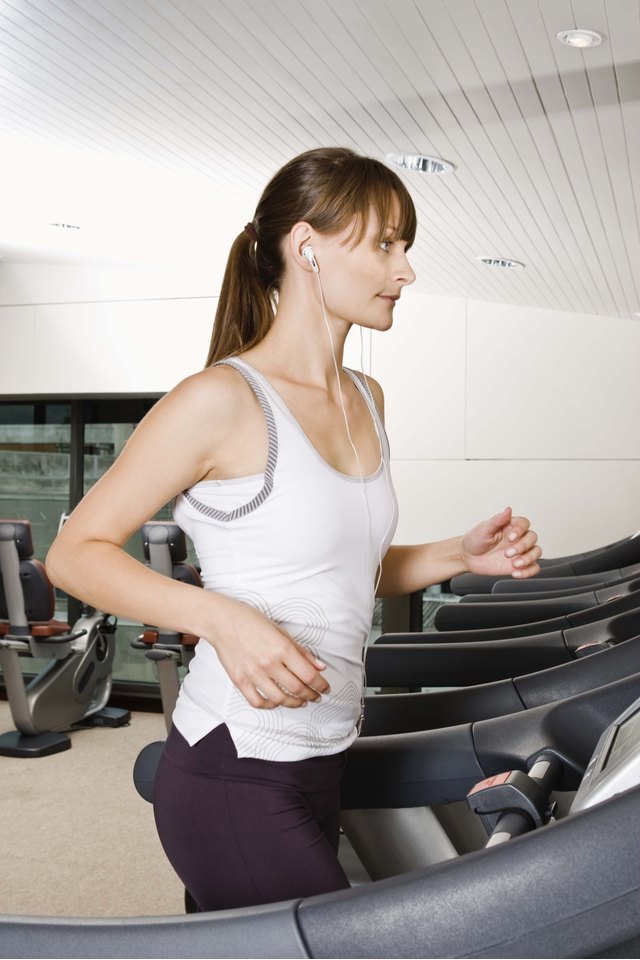What does fact checked mean?
At SportsRec, we strive to deliver objective content that is accurate and up-to-date. Our team periodically reviews articles in order to ensure content quality. The sources cited below consist of evidence from peer-reviewed journals, prominent medical organizations, academic associations, and government data.
The information contained on this site is for informational purposes only, and should not be used as a substitute for the advice of a professional health care provider. Please check with the appropriate physician regarding health questions and concerns. Although we strive to deliver accurate and up-to-date information, no guarantee to that effect is made.
Does Stair Climbing Burn More Calories Than the Treadmill?

A little cardio can go a long way. As little as 2 1/2 hours each week can lower your risk of disease and moderately impact your body weight, according to the American College of Sports Medicine. Treadmills and stair climbing machines are two common pieces of cardiovascular equipment found in gyms. In general, treadmill walking and jogging burn less calories than a stair climber, but running burns more than the stairs.
Stair Climbing Machines
There are different types of stair climbing machines: stepper machines with side rails, stepper with high rails, rotating stairs with side rails and stepper with movable hand rails. They are all similar in that you use the large muscles of your lower body to push the steps, raise your heart rate and burn calories. A 160-lb. person can burn approximately 657 calories in one hour on a stair treadmill, or rotating stair machine, according to MayoClinic.com.
Treadmills
Treadmills also use the muscles of your lower body for your workout. On a treadmill, you can choose to walk, jog or run. The same 160-lb. person walking at 3.5 mph burns approximately 277 calories per hour on a treadmill. If he increases his pace and jogs at 5.0 mph, he can burn up to 584 calories. Running at 8.0 mph, this 160-lb. person can burn up to 986 calories, significantly more calories than from jogging or using a stair climber.
Role of Intensity
The key to calorie burning is intensity. The higher your intensity, the greater the rise in your heart rate and the harder your body works. There is a positive correlation between heart rate and calories burned, which is illustrated by the increase in caloric burn from walking to jogging. On a treadmill, you can also increase your intensity by adding incline to simulate running uphill. Keep intensity moderate to high during your workouts to burn the most calories, as well as to gain the most health benefits.
Other Considerations
Your fitness level and body weight also affect how many calories you burn. If running is easy for you because you do it all the time, the stairs are going to probably burn more calories and vice versa. Change your activity to increase your caloric burn. Also, the heavier you are, the more calories you burn during a workout because your body has to work harder to move your weight. As you lose weight and become more fit, you will not burn as many calories during the same workout.
References
- MayoClinic.com; Exercise For Weight Loss: Calories Burned in 1 Hour; Dec. 2009
- Calorie Burners: Activities that turn up the heat. American Council on Exercise
- Li SSW, Chan OHT, Ng TY, et al. Gender Differences in Energy Expenditure During Walking With Backpack and Double-Pack Loads. Hum Factors. 2018;:18720818799190. doi:10.1177/0018720818799190
- Chang CH, Lin KC, Ho CS, Huang CC. Accuracy of the energy expenditure during uphill exercise measured by the Waist-worn ActiGraph. J Exerc Sci Fit. 2019;17(2):62-66. doi:10.1016/j.jesf.2019.01.003
- Champagne CM, Broyles ST, Moran LD, et al. Dietary intakes associated with successful weight loss and maintenance during the Weight Loss Maintenance trial. J Am Diet Assoc. 2011;111(12):1826-35. doi:10.1016/j.jada.2011.09.014
- LAYDEN, J. D., PATTERSON, M. J., & NIMMO, M. A. (2002). Effects of reduced ambient temperature on fat utilization during submaximal exercise. Medicine & Science in Sports & Exercise, 34(5), 774–779. doi:10.1097/00005768-200205000-00008
- Li, S. S. W., Chan, O. H. T., Ng, T. Y., Kam, L. H., Ng, C. Y., Chung, W. C., & Chow, D. H. K. (2018). Gender Differences in Energy Expenditure During Walking With Backpack and Double-Pack Loads. Human Factors: The Journal of the Human Factors and Ergonomics Society, 61(2), 203–213. doi:10.1177/0018720818799190
- Michael N. Sawka,1 C. Bruce Wenger, Andrew J. Young, and Kent B. Pandolf. Physiological Responses to Exercise in the Heat. Copyright 1993 by the National Academy of Sciences. All rights reserved.
- Morio, B., Beaufrere, B., Montaurier, C., Verdier, E., Ritz, P., Fellmann, N., … Vermorel, M. (1997). Gender differences in energy expended during activities and in daily energy expenditure of elderly people. American Journal of Physiology-Endocrinology and Metabolism, 273(2), E321–E327. doi:10.1152/ajpendo.1997.273.2.e321
- Yue, A. S. Y., Woo, J., Ip, K. W. M., Sum, C. M. W., Kwok, T., & Hui, S. S. C. (2007). Effect of age and gender on energy expenditure in common activities of daily living in a Chinese population. Disability and Rehabilitation, 29(2), 91–96. doi:10.1080/09638280600662232
- Ainsworth, B.; Haskell, W.; Herrmann, S. et al. Compendium of Physical Activities: A Second Update of Codes and MET Values. Med Sci Sports Exercise. 2011;43:1575. DOI: 10.1249/MSS.0b013e31821ece12.
- American Council on Exercise. (2009) Fit Facts - Calories Burners: Activities That Turn Up the Heat. San Diego, California: American Council on Exercise.
Writer Bio
Bethany Kochan began writing professionally in 2010. She has worked in fitness as a group instructor, personal trainer and fitness specialist since 1998. Kochan graduated in 2000 from Southern Illinois University with a Bachelor of Science in exercise science. She is a Certified Strength and Conditioning Specialist, Certified Personal Trainer, Medical Exercise Specialist and certified YogaFit instructor.
